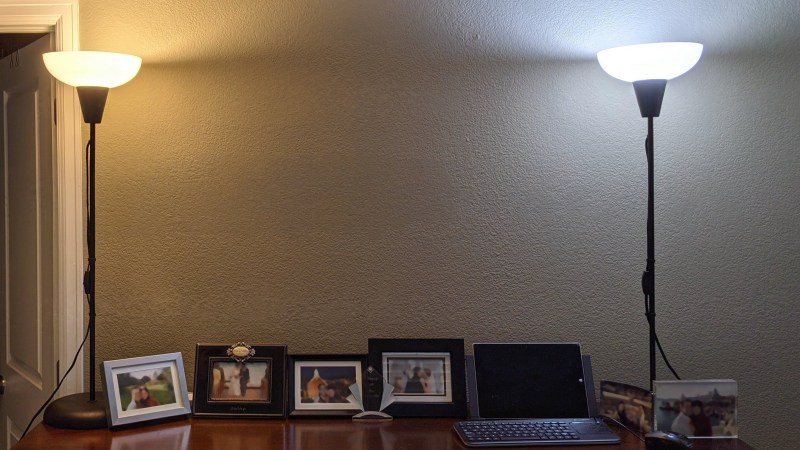[Jon] wants his home office lighting to mimic the light outside, at least from a color perspective. To that end, he has embarked on a design which monitors both the outdoor light and at his work station, and accordingly drives a pair of LED lamps of different colors. One lamp is rated at above 5000 K and provides “cool” lighting, , and the other is rated at less than 3000 K for “warm” lighting.

Commercial solutions do exist, but they are proprietary and do this within a single bulb and seem difficult to control in an orchestrated manner throughout the house. [Jon] plans for his approach to be scalable, eventually consisting of a variety of lighted areas of the house from a single microcontroller.
One of the design goals for this project is to create something that could disappear into the room, rather than the science fair aesthetic of my prior project.
One commenter on his project’s site asked why [Jon] is doing this, that is, what is the value of controlling the color of your indoor lighting? While [Jon] doesn’t have a specific goal in mind at the moment, he notes that these techniques could potentially be helpful for enhancing productivity, managing circadian rhythms, and as light therapy for seasonal depression.
We covered [Jon]’s science-fair-like project that in this writeup from last year. If the topic interests you, check out the white papers he links on his project page for further reading.

















https://github.com/basnijholt/adaptive-lighting
I work in LED driver design. One area we looked into was developing warm/cool lighting for museums, where they’d like to control the color temperature of illumination for art to give it consistent visual appeal independent of any stray external lighting.
Managing light temperature is very important for everything from accurate colour rendition, to avoiding horrible colour casts on video, to getting to sleep at night.
IKEA sells dual color (warm and cold) temperature lightbulbs in their tradfri series. I guess tying a light sensor to a ZigBee network would do the same trick? As for the bulbs themselves, I think you can put riot + the zboss ZigBee stack on them nowadays …
Using 2 seperate bulbs doesn’t seem that practical… But this would be great controlling ZigBee white balance bulbs
As long as they’re enjoying it though power to them.
I have a cheapish zigbee/BLE bulb in my office that allows me to set the colour temp across a wide spectrum remotely. I think it was sold under the Hive brand in the UK. Sorry for vague details, but it was installed years ago now. But such things did/presumably do already exist.
Playing devils advocate here, as I’m working on something similar to determine light intensity for my office. But why use sensors to determine the light temperature outside? The local time of sunset and sunrise will always be known values, so just calculate the lighting temperature based on the sun’s position. It will not be as exact as the temperature determined by a pair of sensors, but it comes close enough for human perception. And it’s not affected by weather conditions. This is how I’ve automated the light temperature of all the bulbs in my house— it makes a world of difference in the winter and when getting up in the morning.